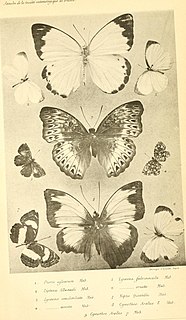
Smilax ornata is a perennial trailing vine with prickly stems that is native to Mexico and Central America. Common names include sarsaparilla, Honduran sarsaparilla, and Jamaican sarsaparilla.

The Sri Lanka blue magpie or Ceylon magpie is a brightly coloured member of the family Corvidae, found exclusively in Sri Lanka. This species is adapted to hunting in the dense canopy, where it is highly active and nimble. Its flight is rather weak, though, and is rarely used to cover great distances. In spite of the Sri Lanka blue magpie's ability to adapt to the presence of humans, it is classified as vulnerable to extinction due to the fragmentation and destruction of its habitat of dense primary forest in the wet zone of southern Sri Lanka.

Chrysopelea ornata is a colubrid snake found in both South and Southeast Asia. It is, along with the other species in its genus Chrysopelea, very unusual in that it is capable of a type of gliding flight. It is also rear-fanged. Currently, three subspecies are recognized. The snake's striking looks and capability of gliding make it a popular choice for captivity.

Terrapene ornata is a species of North American box turtle sometimes referred to as the western box turtle or the ornate box turtle. It is one of two recognized species of box turtle in the United States, having two subspecies. The second recognized species of box turtle is the eastern box turtle,Terrapene carolina. T. carolina has six subspecies, two of which are endemic to Mexico.

Banksia ornata, commonly known as desert banksia, is a species of shrub that is endemic to south-eastern continental Australia. The Ngarrindjeri people of the Lower Murray region in South Australia know it as yelakut. It has thin bark, serrated, narrow egg-shaped leaves with the lower end towards the base, cream-coloured flowers in a cylindrical spike, and later, up to fifty follicles in each spike, surrounded by the remains of the flowers.

The Morphinae are a subfamily of Nymphalidae butterflies that includes the morphos, the owl butterflies (Caligo), and related lineages. It is either considered a sister group of the Satyrinae, or disassembled and included therein.

The European White Elm cultivar Ulmus laevis 'Ornata' was erroneously identified by Carrière as U. communis ornata in 1858. 'Ornata' was named by Carrière for the numerous and intensely green leaves which gave the trees 'a magnificent appearance'.

Rupicapra is a genus of goat-antelope called the chamois. They belong to the bovine family of hoofed mammals, the Bovidae.

Rhinella ornata is a species of toad in the family Bufonidae that is found in Brazil and possibly Argentina. Its natural habitats are subtropical or tropical moist lowland forests, rivers, and intermittent freshwater lakes. It is threatened by habitat loss.

Chitala is a genus of fish of the family Notopteridae. This genus contains six species, in which some are important in aquaculture and the aquarium industry. They are commonly known as the Asian knifefishes or featherbacks. They are native to freshwater in South and Southeast Asia.

Nothoprocta is a genus of birds belonging to the tinamou family Tinamidae. They inhabit scrubland, grassland and open woodland in western South America, particularly in the Andes. They are poor fliers and spend most of their time on the ground. Their diet includes seeds and insects. They nest on the ground, laying large glossy eggs. The eggs are covered with feathers when a potential predator is nearby.

The ornate box turtle is one of only two terrestrial species of turtles native to the Great Plains of the United States. It is one of the two different subspecies of Terrapene ornata. It is the state reptile of Kansas and Nebraska. It is currently listed as threatened in Illinois and is of concern and protected in six Midwestern states.

Scopula ornata, the lace border, is a moth of the family Geometridae. The species was first described by Giovanni Antonio Scopoli in his 1763 Entomologia Carniolica. It is found in Europe, North Africa and the Near East.

The ornate slider is turtle belonging to the genus Trachemys of the family Emydidae. It is found in Guerrero, Jalisco, Nayarit and Sinaloa in western Mexico.

Morphini is a tribe of nymphalid butterflies in the subfamily Morphinae.

Oboronia ornata, the untailed ginger white, is a butterfly in the family Lycaenidae. It is found in Guinea, Sierra Leone, Liberia, Ivory Coast, Ghana, Togo, Nigeria, Cameroon, Equatorial Guinea, Gabon, the Republic of the Congo, the Democratic Republic of the Congo, Uganda and Tanzania. The habitat consists of forests and Guinea savanna in riparian vegetation.

Antirrhea philoctetes, the common brown morpho or northern antirrhea, is a butterfly of the family Nymphalidae. It was described by Carl Linnaeus in 1758. It is found in Costa Rica, Panama, Guatemala, Colombia, Venezuela, the Guianas, Peru, Brazil and Bolivia.
Denazinemys was a genus of baenid turtle that lived in the Late Cretaceous of New Mexico. The holotype specimen, which D. nodosa was based on, USNM 8345, consists of a partial carapace and plastron. It came from the De-na-zin Member of the Kirtland Formation, and therefore, Denazinemys lived in the Kirtlandian land-vertebrate age. Many specimens other than the holotype have been assigned to Denazinemys.

The Southeast Asian softshell turtle is a species of softshell turtle in the family Trionychidae.

Box turtle is the common name for several species of turtle. It may refer to those of the genus Cuora or Pyxidea, which are the Asian box turtles, or more commonly to species of the genus Terrapene, the North American box turtles. They are largely characterized by having a shell shaped like a dome, which is hinged at the bottom, allowing the animal to close its shell tightly to escape predators. Furthermore, the two genera are very different in habitat, behavior and appearance, and are not even classified in the same family. Even though box turtles became very popular pets, their needs in captivity are complex and the capture of turtles can have serious detrimental effects on the wild population.




















